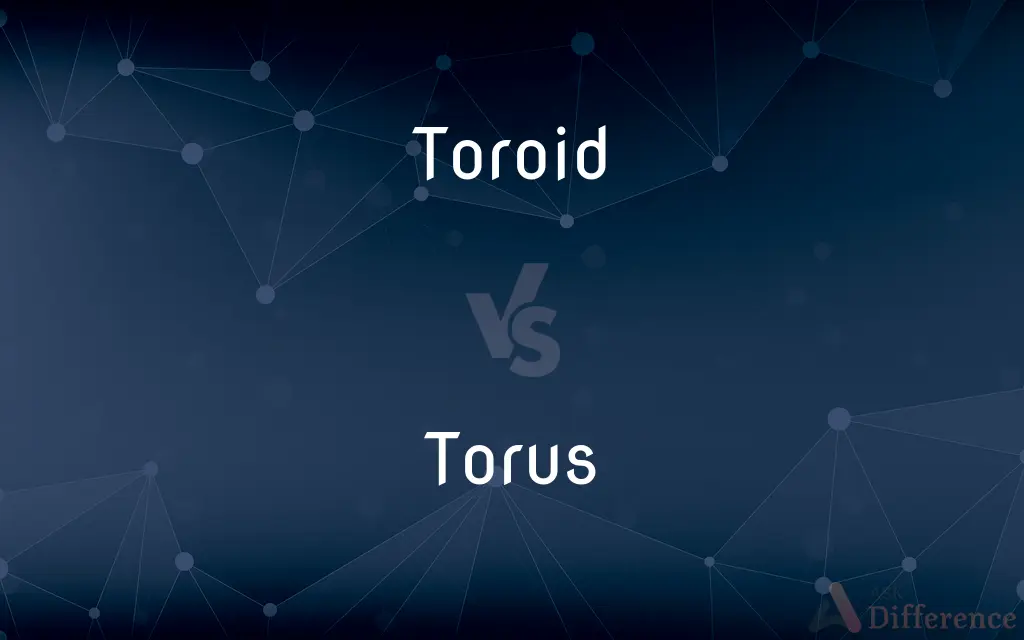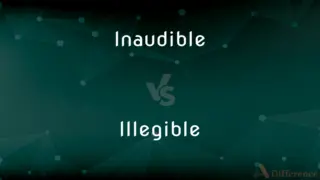Toroid vs. Torus — What's the Difference?
Edited by Tayyaba Rehman — By Urooj Arif — Updated on June 24, 2024
A toroid is a shape resembling a donut, often used in electromagnetics for coils and transformers, focusing on its functional geometry, while a torus is a mathematical surface defined by rotating a circle around an axis.

Difference Between Toroid and Torus
Table of Contents
ADVERTISEMENT
Key Differences
Toroids are commonly associated with their use in electrical engineering, specifically in the design of inductors and transformers, where the donut-shaped core helps to minimize electromagnetic interference. On the other hand, a torus is primarily a mathematical concept used in geometry to describe a surface generated by rotating a circle in three-dimensional space around an axis that does not intersect the circle.
The design of a toroid in practical applications is optimized for efficiency and minimal energy loss, crucial for electronic devices and systems. Whereas the study of a torus in mathematics involves understanding its properties, such as volume and surface area, which are of theoretical interest rather than practical application.
Toroids often have materials like ferrite or iron to concentrate magnetic fields, enhancing the efficiency of electrical components. In contrast, a torus, being a theoretical shape, does not concern itself with materials but rather with the relationships and equations that define its structure.
The geometry of a toroid is specifically tailored to its application in electrical circuits, with variations like the toroidal transformer being key to its functionality. Meanwhile, the geometry of a torus is defined by parameters such as the radii of the generating circle and the path of rotation, which determine its shape but not its function.
Despite their similarities, the context in which toroids and tori are discussed separates their significance: toroids in practical engineering and magnetic field management, and tori in abstract mathematical theory and geometric exploration.
ADVERTISEMENT
Comparison Chart
Definition
A donut-shaped object used in engineering to minimize electromagnetic interference
A mathematical surface formed by rotating a circle around an axis
Application
In electrical engineering for inductors and transformers
In theoretical mathematics and geometry
Material Concern
Made of materials like ferrite or iron for functionality
Material is irrelevant; focuses on geometric properties
Purpose
To enhance efficiency and minimize energy loss in electrical components
To explore theoretical properties and geometric relationships
Context
Practical, with emphasis on application in technology
Theoretical, with emphasis on mathematical exploration
Compare with Definitions
Toroid
A component critical for minimizing electromagnetic interference.
Using a toroid, we've significantly cut down on energy loss.
Torus
A mathematical shape created by rotating a circle around an axis.
The torus we're studying has fascinating surface area properties.
Toroid
An object designed to efficiently manage magnetic fields.
Our new inductor design incorporates a toroid for better performance.
Torus
A focus in mathematics on the properties of curved surfaces.
Calculating the volume of this torus involves integral calculus.
Toroid
A donut-shaped core used in electrical engineering.
The toroid was chosen for the transformer to reduce interference.
Torus
The theoretical concept of a donut-shaped surface in geometry.
He modeled a torus to demonstrate rotational symmetry.
Toroid
A specific shape used in technology to enhance electrical efficiency.
Toroids are preferred in high-end audio equipment for their minimal leakage.
Torus
A geometric figure used to explore complex mathematical theories.
The torus is central to our discussion on topological spaces.
Toroid
The practical application of a donut-shaped geometry in electronics.
This toroid ensures our circuit maintains a compact size.
Torus
An abstract shape that helps in understanding spatial relationships.
By analyzing a torus, students learn about three-dimensional geometry.
Toroid
In mathematics, a toroid is a surface of revolution with a hole in the middle. The axis of revolution passes through the hole and so does not intersect the surface.
Torus
In geometry, a torus (plural tori, colloquially donut) is a surface of revolution generated by revolving a circle in three-dimensional space about an axis that is coplanar with the circle. If the axis of revolution does not touch the circle, the surface has a ring shape and is called a torus of revolution.
Toroid
A surface generated by a closed curve rotating about, but not intersecting or containing, an axis in its own plane.
Torus
(Architecture) A large convex molding, semicircular in cross section, located at the base of a classical column.
Toroid
A solid having such a surface.
Torus
(Anatomy) A bulging or rounded projection or swelling.
Toroid
A body having the shape of a toroid.
Torus
The receptacle of a flower.
Toroid
(mathematics) A surface generated by a closed curve (especially a circle) rotating about, but not intersecting or containing, an axis in its own plane. Category:en:Surfaces
Torus
A thickened area in the middle of the membrane that connects the pits of tracheids in conifers and certain other gymnosperms.
Toroid
A ring-shaped object whose surface is a torus.
Torus
(Mathematics) A toroid generated by a circle; a surface having the shape of a doughnut. Also called tore2.
Toroid
The doughnut-shaped object enclosed by a torus
Torus
(geometry) The standard representation of such a space in 3-dimensional Euclidean space: a surface or solid formed by rotating a closed curve, especially a circle, about a line which lies in the same plane but does not intersect it (e.g. like a ring doughnut). Category:en:Surfaces
Toroid
A ring-shaped surface generated by rotating a circle around an axis that does not intersect the circle
Torus
(topology) A topological space which is a product of two circles.
A 4-variable Karnaugh map can be thought of, topologically, as being a torus.
Solid torus
Torus
A ring-shaped object, especially a large ring-shaped chamber used in physical research.
Torus
(architecture) A large convex molding, typically semicircular in cross section, which commonly projects at the base of a column and above the plinth.
Torus
(anatomy) A rounded ridge of bone or muscle, especially one on the occipital bone.
Torus
(botany) The end of the peduncle or flower stalk to which the floral parts (or in the Asteraceae, the florets of a flower head) are attached.
Torus
(botany) The thickening of a membrane closing a wood-cell pit (as of gymnosperm tracheids) having the secondary cell wall arched over the pit cavity.
Torus
A large molding used in the bases of columns. Its profile is semicircular. See Illust. of Molding.
Torus
One of the ventral parapodia of tubicolous annelids. It usually has the form of an oblong thickening or elevation of the integument with rows of uncini or hooks along the center. See Illust. under Tubicolæ.
Torus
The receptacle, or part of the flower on which the carpels stand.
Torus
The surface described by the circumference of a circle revolving about a straight line in its own plane.
Torus
A ring-shaped surface generated by rotating a circle around an axis that does not intersect the circle
Torus
Commonly the lowest molding at the base of a column
Common Curiosities
What is the primary difference between a toroid and a torus?
The primary difference is application: toroids are practical components in electrical engineering, while tori are theoretical shapes in mathematics.
How does the material of a toroid affect its functionality?
The material of a toroid, like ferrite or iron, is crucial for its ability to concentrate magnetic fields and improve the efficiency of electrical devices.
Why is the study of tori important in mathematics?
Studying tori helps in understanding complex geometric properties, spatial relationships, and contributes to fields like topology.
What makes toroids preferred in certain electrical applications?
Toroids are preferred due to their efficient shape that minimizes electromagnetic interference and energy loss, crucial for high-performance electronics.
Can the concept of a torus apply to other fields outside of mathematics?
Yes, the geometric properties of a torus are applicable in computer graphics, architecture, and even in understanding some natural phenomena.
How does the efficiency of a toroidal transformer compare to traditional transformers?
Toroidal transformers are generally more efficient due to their design, which minimizes magnetic flux leakage and core losses.
What advancements have been made in the use of toroids in technology?
Advancements include improvements in materials and manufacturing techniques, making toroids more efficient and effective in a wide range of applications.
Can a torus be used in practical applications like a toroid?
While a torus itself is a theoretical concept, its shape inspires practical applications, such as in the design of toroids for electrical components.
How do toroids help in reducing energy loss?
By concentrating magnetic fields more effectively and reducing external magnetic interference, toroids help in minimizing energy loss in circuits.
Why is it important to distinguish between a toroid and a torus?
Distinguishing between them is crucial for clarity in communication, ensuring that discussions are relevant to the intended field, whether practical engineering or theoretical mathematics.
What role does the axis of rotation play in defining a torus?
The axis of rotation determines the shape of the torus, specifically the distance from the center of the generating circle to the axis affects the torus's thickness.
Is the volume calculation of a toroid similar to that of a torus?
Volume calculations for practical toroids focus on material properties, whereas a torus's volume calculation is a theoretical geometric problem.
How does the mathematical study of a torus contribute to technology?
Understanding the properties of a torus can influence design principles in technology, from the creation of efficient structures to the optimization of spatial layouts.
Are there different types of tori in mathematics?
Yes, there are different types of tori defined by the radius of the generating circle and the distance from the axis, such as ring and horn tori.
Can the concept of a torus be visualized in everyday objects?
Yes, everyday objects like donuts or inner tubes share the geometric shape of a torus, making it easier to visualize.
Share Your Discovery

Previous Comparison
Peacefully vs. Resting
Next Comparison
Inaudible vs. IllegibleAuthor Spotlight
Written by
Urooj ArifUrooj is a skilled content writer at Ask Difference, known for her exceptional ability to simplify complex topics into engaging and informative content. With a passion for research and a flair for clear, concise writing, she consistently delivers articles that resonate with our diverse audience.
Edited by
Tayyaba RehmanTayyaba Rehman is a distinguished writer, currently serving as a primary contributor to askdifference.com. As a researcher in semantics and etymology, Tayyaba's passion for the complexity of languages and their distinctions has found a perfect home on the platform. Tayyaba delves into the intricacies of language, distinguishing between commonly confused words and phrases, thereby providing clarity for readers worldwide.












































